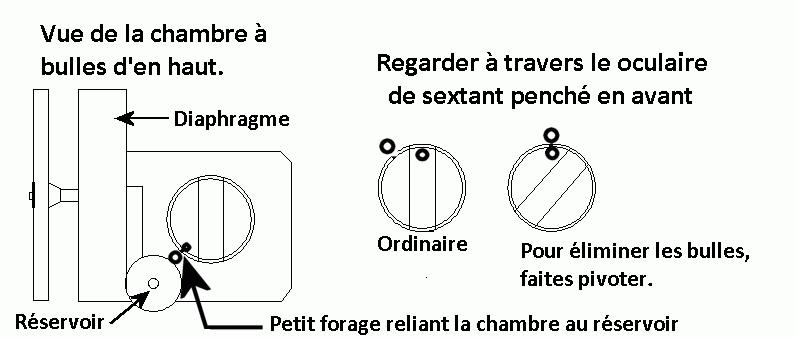

If you were to open your Mk IX you would see in the left half of the instrument the bubble chamber assembly. The left hand drawing above shows a view from directly above the chamber when it is in a normal (vertical) operating position. The right hand sketch shows the view as seen through the eyepiece, I have exaggerated the size of the drilling just to give you some idea of its position.
Si vous ouvriez votre Mk IX, vous verriez dans la moitié gauche de l'instrument l'assemblage de la chambre à bulles. Le dessin de gauche ci-dessus montre une vue directement au-dessus de la chambre lorsque celle-ci est dans une position de fonctionnement normale (verticale). Le croquis de droite montre la vue vue à travers l'oculaire. J'ai exagéré la taille du forage pour vous donner une idée de sa position.
To check the bubble:- Position yourself under a source of light so that light comes through the frosted window with an open shutter on top of the instrument. Set in maximum sun shades so a minimum of light comes in through the front. Look through the eye piece. You should see a circle. There may or may not be a visible bubble in this circle. The bubble chamber forms a "Bulls Eye" type of level, not a standard tubular "Builders" level. The bubble will centralise when the instrument is vertical. You will notice at about the 10 O'clock position a small notch. If you have a large bubble in view, lean forward and to the right so this notch is at the 12 O'clock position. Now wind in and out the diaphragm knob gently, the bubble of air should leave by the notch, which is actually a tube into the reservoir and should be replaced by liquid. To generate a bubble stand the instrument vertical and turn the diaphragm knob clockwise, This action will increase the volume under the diaphragm, dragging fluid from the reservoir till it is exhausted and the air above it is drawn in forming a bubble. Take care not to force anything.
Pour vérifier la bulle: - Placez-vous sous
une source de lumière de sorte que la lumière passe
à travers la fenêtre dépolie avec un obturateur
ouvert au-dessus de l'instrument. Placez-vous à l'ombre
maximale du soleil afin qu'un minimum de lumière pénètre
à l'avant. Regardez à travers le oculaire. Vous
devriez voir un cercle. Il peut y avoir ou non une bulle visible
dans ce cercle. La chambre à bulles forme un niveau de
type "Bulls Eye" et non un niveau standard tubulaire
"Builders". La bulle se centralisera lorsque l'instrument
est vertical. Vous remarquerez à peu près à
la position 10 heures un petit cran. Si vous avez une grande bulle
en vue, penchez-vous en avant et à droite pour que cette
encoche se trouve à la position 12 heures. Maintenant,
enroulez doucement le bouton du diaphragme, la bulle d'air doit
sortir par l'encoche, qui est en fait un tube dans le réservoir
et doit être remplacée par du liquide. Pour générer
une bulle, placez l'instrument à la verticale et tournez
le bouton de la membrane dans le sens des aiguilles d'une montre.
Cette action augmentera le volume sous la membrane, entraînant
le fluide dans le réservoir jusqu'à son épuisement
et l'air aspiré formant une bulle. Veillez à ne
rien forcer.